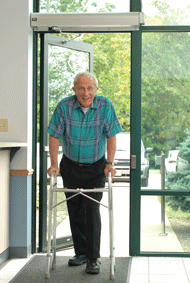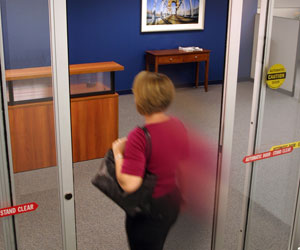ANSI and the Customer at Your Door
Automatic door equipment is evaluated for compliance to minimum safety standards
As a premise owner, architect, contractor, or other professional responsible for growing a business, it’s easy to overlook some basic issues that could affect the safety of customers – starting with your front door.
Typical factors that hamper people from easily and safely accessing a building can involve heavy manual swing doors, inefficient vestibule layouts, or difficult traffic patterns. Fortunately, automatic doors are specifically designed to move people efficiently and safely into and out of a building. Automatic swing, slide, and folding doors each have unique characteristics that offer customers ease of access and energy-saving features for a variety of businesses.

Thanks to the ANSI/BHMA standards (American National Standards Institute/Builders Hardware Manufacturers Association) – both full-power (ANSI/BHMA A156.10) and low-energy (ANSI/BHMA A156.19) automatic door equipment can be evaluated for compliance to minimum safety standards.
For full-power doors, the revised standard was approved on Sept. 20, 2005. Full-power swing, slide, and fold doors are defined as automatically opening when approached by pedestrians and some small vehicular traffic, or by a knowing act such as a card reader or other type of switch. Because of the force and speed in which they move, additional safety features are associated with these types of doors.
The low-energy door standard is in process of revision at this time. “Low energy” applies to swing doors only. The two most common types of low-energy swing doors are “power operated” and “power open.” A power-operated swing door opens and closes upon receipt of an actuating signal and does not generate more kinetic energy while opening or closing than specified in the standard. Similarly, a power-open swing door opens upon receipt of an actuating signal and does not generate more kinetic energy while opening, but closes by other means, such as a hydraulic closer. These are slow-moving doors with minimal force required to stop. Typical applications are offices, libraries, and other similar institutions.
Maintenance of automatic pedestrian door equipment is no exception and also requires periodic servicing and inspection to ensure compliance with ANSI/BHMA standards. It is strongly recommended that an inspector certified by the Cleveland-based American Association of Automatic Door Manufacturers (AAADM) inspect all automatic pedestrian doors at the time of installation and, at a minimum, annually. It is also recommended that a qualified professional maintain the doors on a regular basis according to the manufacturer’s instructions.

Modern technology can find ways of improving even the simple door! As part of our door installation survey our engineers can advise you on all the options and available and how well they may be applied to your specific property and requirement. To learn more, contact our team today and arrange for a consultation throughout Toronto.
John Cianciolo is vice president of engineering at Muskego, WI-based NABCO Entrances Inc (www.nabcoentrances.com).
WE SERVE AUTOMATIC DOORS IN GTA AREAS
Modern technology can find ways of improving even the simple door! As part of our door installation survey our engineers can advise you on all the options and available and how well they may be applied to your specific property and requirement. To learn more, contact our team today and arrange for a consultation throughout Toronto.
